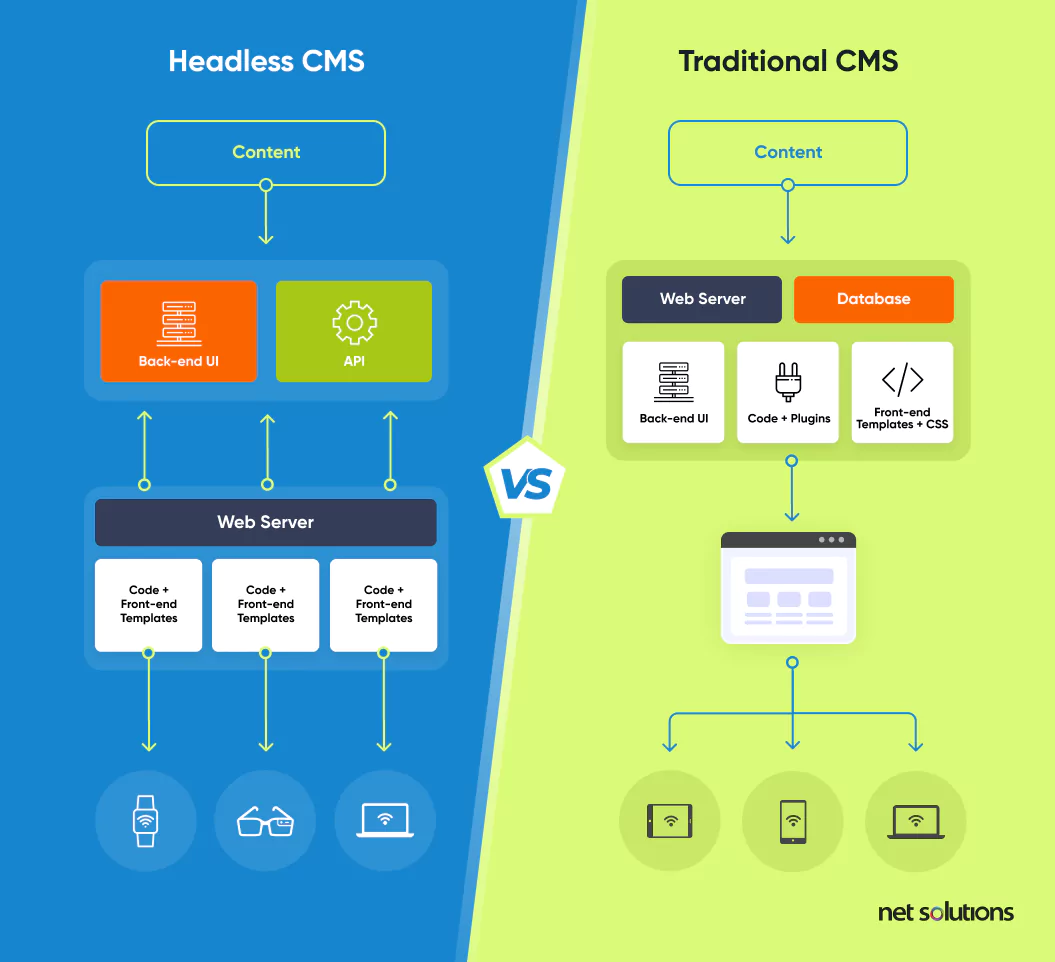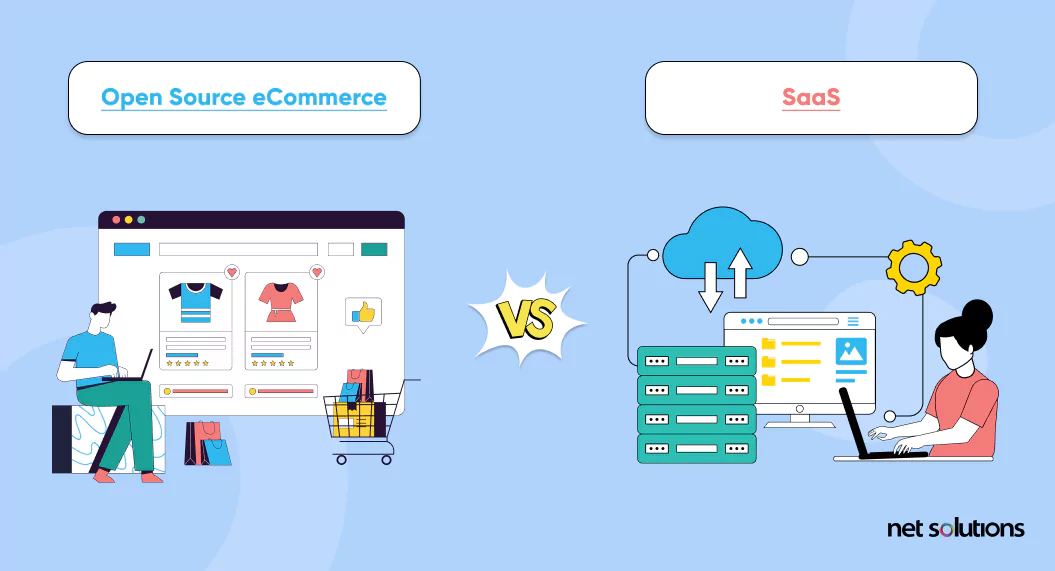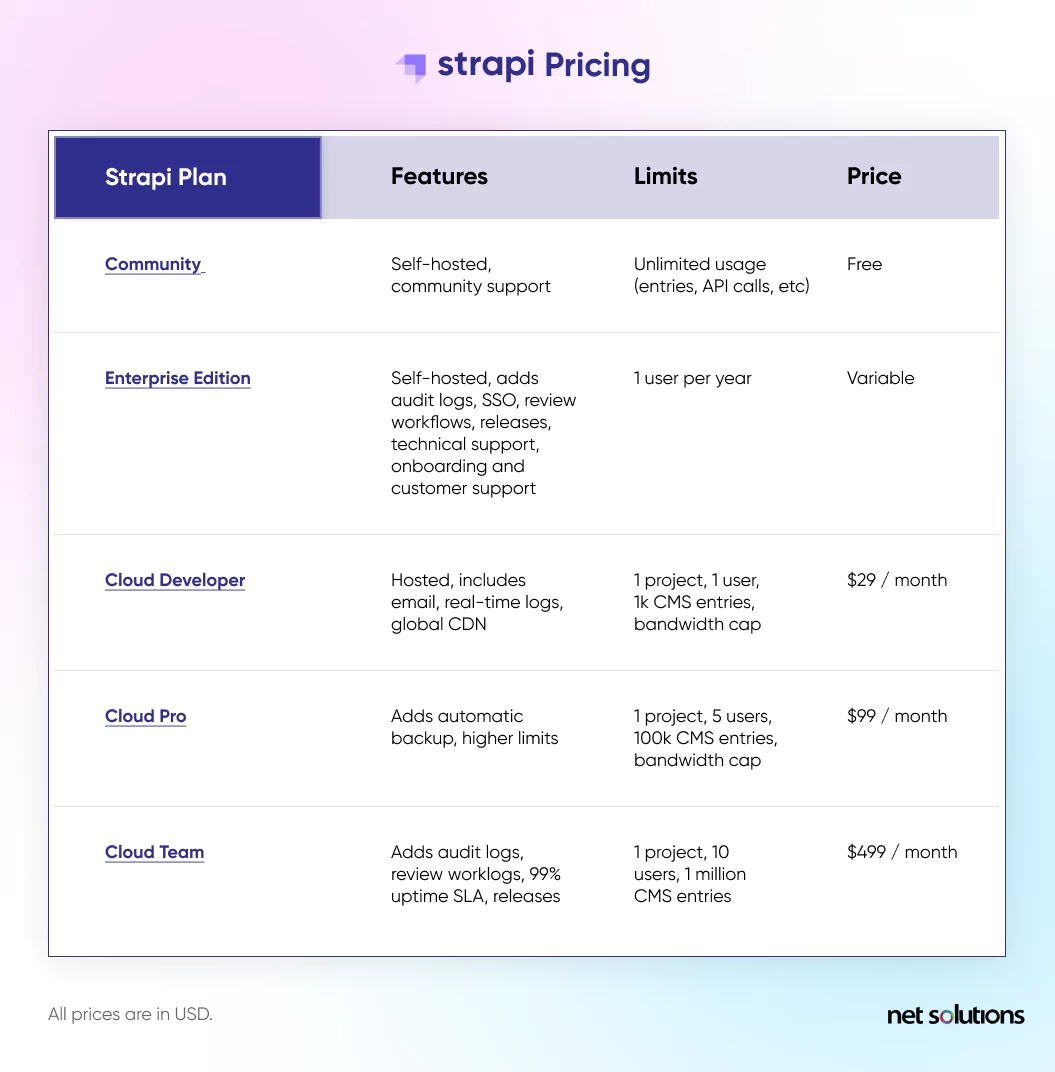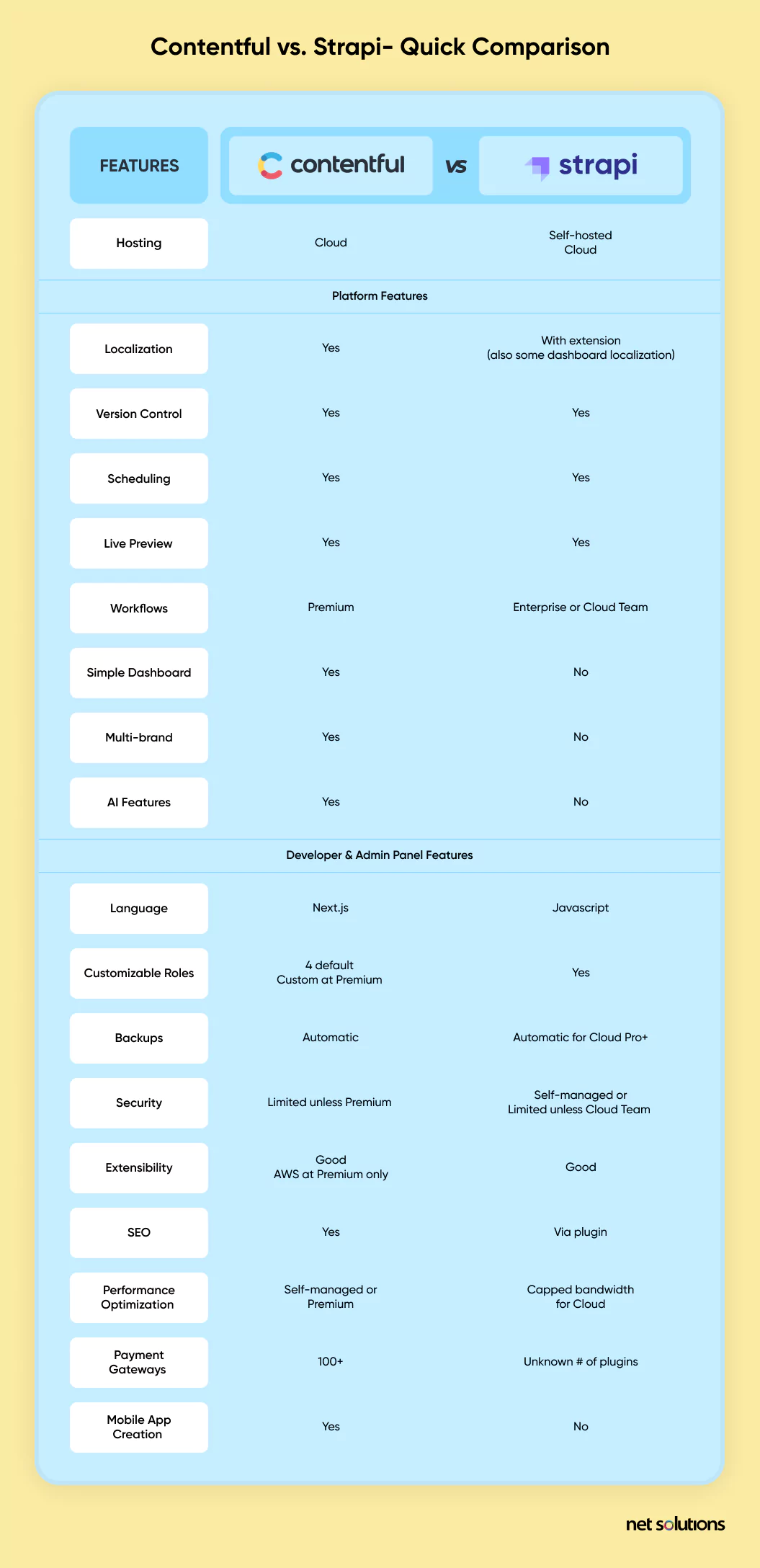Organizations and individuals today are increasingly adopting headless content management systems (CMS) to support a content-driven marketing strategy that makes it easier to create content and deliver it in an optimized way to an increasing number of digital touchpoints and channels, be that smartphones, smart watches, social media platforms or more. Strapi and Contentful are two of the top headless CMS options, with Contentful representing the #1 headless CMS with 35.84% market share.
The main difference between Strapi and Contentful is their open-source (Strapi) and software-as-a-service (SaaS) offerings. Recently, Strapi has made inroads with its Strapi Cloud offerings, though they are not as comprehensive as Contentful solutions.
In this guide, you will find a complete comparison between these two headless CMS systems and how they impact both marketers (who need ease) and developers (who want flexibility), including:
- Technical differences and their benefits or limitations
- The ease of use of each platform
- The features of each platform
- Integration considerations
- Scalability and performance
- Security considerations
What is a Headless CMS?
A content management system (CMS) is software used to create, organize, publish, and subsequently manage all the digital content (blog posts, product pages, eBooks, etc) for websites and online stores, often with the support of templates and interfaces. While rigid traditional CMS has dominated eCommerce for many years, the emergence of new shopping touch points across mobile and social media has been challenged by the inflexibility and extra work of traditional CMS. In many cases, content had to be duplicated across channels, leading to inefficient content management processes and discrepancies between channels.
A headless CMS such as Contentful or Strapi will separate the frontend (what you see and work with) and the backend (where the content lives) to allow organizations to deploy composable content optimized and delivered to any digital touchpoint without duplication of content. Further, headless CMS is known as API-first, leveraging APIs to communicate with distinct digital channels with the programming language or framework best suited to each.

Internally, headless CMS is becoming the CMS of choice: web developers and software engineers praise efficiency and scalability; content creators and digital marketers praise the flexibility and ability to streamline content marketing or support omnichannel retailing goals; decision-makers such as CTOs and project managers look to improved digital strategies, achieve operational efficiencies, and help foster team collaboration.
As noted above, the primary difference between Strapi and Contentful is hosting. So, let’s break that down.
What are SaaS and Open-Source eCommerce Platforms?
To compare Strapi vs. Contentful, it’s first essential to understand the differences between a hosted (SaaS) vs. an unhosted (open-source) eCommerce solution:
Open-source software such as Strapi can be downloaded and used for free, with access to the source code for complete control over developing, customizing, launching, and maintaining online stores in a self-hosted environment. All development, maintenance, hosting, and integrations have additional costs and considerations.
Software as a service (SaaS) refers to software hosted in the cloud by a third party, such as Contentful and (within limits) some Strapi Cloud options. Contentful provides access to its software to design online stores from the convenience of a web browser. SaaS paid plans include all the software maintenance, hosting, security, performance, and customer service, represented by a monthly or yearly base cost, not including integrations.
Contentful Overview
Contentful, a leading digital experience platform solutions provider, is a headless content management system (CMS) founded in 2013. Today, it supports notable global brands, including IKEA, the British Museum, Twilio, and Red Bull. Contentful sells itself as a “platform for intelligent digital experiences,” moving away from technical language about the platform itself (headless CMS) toward what that platform enables and its ability to quickly harness evolving technology to meet consumer needs, including new artificial intelligence (AI) features.
If you came to this guide but have questions about how Contentful compares to Contentstack, we have another guide that can help!
Key Features of Contentful
- Content Studio with AI-integrated tools to streamline workflow and governance
- A Contentful Ecosystem includes a rich marketplace
- App Framework to build web apps to enhance your tech stack and enable greater interaction with apps in the marketplace
- Multi-Support – The core features of the Contentful platform allow for multi-brand and omnichannel experiences, taking the concept of “multiples” to new levels, all on a solid, unified, composable content base.
- Proprietary built-in apps (Task, Compose, Launch) to help deliver content faster
- Create mobile apps
- Content orchestration to create dynamic experiences
- Presence indicator to make collaboration more transparent on shared workspaces
- Localization through a live preview across locales
- Preview-based publishing to see and edit updates in a live preview
- Visual Modeler to create the content model easily, supported by AI Content Type Generator
- API based on REST and GraphQL APIs, including Content Management API, Content Delivery API, Content Preview API, and Images API to retrieve and apply transformations to content and images, GraphQL Content API, User Management API, and SCIM API.
- Content Delivery Networks (CDNs) such as Fastly and Cloudfront for fast content delivery
Advantages of using Contentful
Contentful is a powerful platform that takes composable content to new levels. It allows a single core content base to be used across brands and channels, all from an interface that supports the user experience for content creators, developers, and marketers alike. Premium plans are often used by some of the biggest global brands, with features for governance, scale, high plan limits, and greater support.
- Comprehensive and advanced features
- Option for EU data residency for compliance
- Elevated governance tools
- AI Content Type Generator to help build content quickly
- Designed as a low-code/no-code solution so that anyone can build a website
- Flexible content models support a variety of options (text, video, music, code, structured documents)
Drawbacks of using Contentful
To use a headless CMS, teams must be well-versed in APIs, including REST and GraphQL, to iterate the presentation layers.
- Potential cost increases associated with bandwidth
- Some limits placed on accounts (e.g. asset size, number of users, number of locals, API calls), though limitations decrease at the Premium level
- Content setup can be confusing and difficult to reverse
Contentful pricing
The following Contentful pricing plans are available.
Now let’s have a high-level look at Strapi.
Strapi Overview
Strapi is an open-source CMS, first released as open-source in 2015, but subsequently growing to include a self-hosted Enterprise edition and a fully-managed cloud hosted infrastructure stack, Strapi Cloud, available in different pricing models.
Key features of Strapi
- Self-hosted OR cloud options to have the ultimate control or a bit of a leg up in creating the tech stack. Note that the cloud option is not as comprehensive in-service capabilities as other SaaS platforms.
- Collection types and components help support reusability
- Customizable API allows you to create APIs without coding, and open-source APIs make it possible to customize with code
- Internationalization is supported by the i18n plugin
- Custom fields make it possible to create new content-type structures
- Role-Based Access Controls at all levels to manage least privileged access controls
Advantages of using Strapi
Stapi was designed with developers primarily in mind, featuring strong support for customizing APIs and managing content relationships and components:
- Multilingual CMS to ensure language is not a barrier for creation, management or distribution of localized content
- Even with Cloud, can connect with and change infrastructure at any time
- Built in blog support
Drawbacks of using Strapi
Like with Contentful, users need strong API knowledge, including REST and GraphQL, and additional developer knowledge when self-hosting in order to set up, maintain and secure your environment.
- While Strapi (open-source) is free, total cost of ownership includes hosting, payment processing, web design, web development, security and integration costs
- Updates not quite as regular and not always documented
- Migration challenges
- Interface not as intuitive as others
Strapi pricing
Strapi pricing is now variable based on whether it is self-hosted (community or enterprise) or hosted in the cloud.
Let’s break down each platform to compare the core feature sets.
Contentful vs. Strapi: Quick Comparison
Here’s a quick comparison of the main features of Contentful and Strapi:
Customization capabilities
Strapi open-source lends itself to unlimited customization, allowing developers to optimize the CMS or connect it to systems in any way it wants. Further, the open-source APIs can easily be set up and customized.
On the other hand, Contentful attempts to bridge its customizability by appealing to more internal user groups (even the non-technical) and through a very robust marketplace of integrations. Contentful does offer source code repository for some of its starter templates to open up more customizability.
User-friendliness
How easy is each platform to use? Contentful wins this category. Contentful is cloud-based and includes AI-content generation assistance, default user interface, live preview, and tools that are easy for any user to understand, with pre-built Tasks, Compose, and Launch apps to help deliver content faster. Many people who use Strapi need third-party rich text editors to support the ease of content creation.
Strapi CMS contains several starter templates for stores, websites and blogs, built-in emailing, and the ability to create custom fields for content types. Contentful also includes templates for stores and mobile apps with source-code editing to overcome some frustrations that users sometimes have with SaaS inflexibility.
Cost Considerations
As noted above, there are many factors that influence cost, from self-hosting with all the various add-ons necessary to support a website to the cost of integrations. It is recommended that a careful analysis be taken before choosing a plan, as total cost of ownership is more than just the face value free vs monthly cost.
Integrations and Extensions
Software teams must consider the complexity and technical challenges associated with integrating the CMS with existing marketing tools, e-commerce platforms, and customer relationship management (CRM) systems.
Contentful boasts a robust Ecosystem of best-in-class enterprise solutions to connect your content with external systems via pre-built apps or third-party services in the Marketplace and custom apps.
The Strapi Market does not boast as many enterprise level pre-built apps or integrations, but does include the ability to create custom plugins.
Security
In the face of increasingly sophisticated cyber attacks and emerging regulatory requirements across states, countries and industries, organizations need tools that support a strong security posture.
Contentful offers a strong position, with elevated identity and access management to help safeguard the platform, EU data residency options, support for SSO, authentication, encryption, and backups. Contentful runs a bug bounty program and complies with various laws and regulations including ISO 27001 for all levels and PCI-DSS at Premium.
Strapi requires a significant investment and knowledge of security if self-hosted, including knowledge of SSL, firewalls, anti-virus and anti-malware, spam filters, DDoS protection, encryption, backup, auditing, API security and more. Strapi Coud
Performance
Contentful delivers content as JSON data with its Content Delivery API. Contentful enforces technical limits since its infrastructure is shared, with plans incrementally having higher limits as outlined here.
When self-hosted, there are no technical limitations to Strapi, but implementation optimization requires a depth of knowledge that not all technical teams have. Further, outages are solely the responsibility of the business. In the cloud model, Strapi’s performance cannot compete with Contentful’s.
Let’s see what others have to say next.
Strapi vs Contentful: User Reviews
Following our in-depth comparison of Strapi vs Contentful, we wanted to share with you some user reviews from the peer-to-peer review site G2.
What do users have to say about Strapi?
Users generally indicate that Strapi is fully customizable and extensible, which makes it easy to manage all types of content for multi-channel distribution.
Pros:
- “Ease of use. Easy to add tables and relations between them. I was looking for a headless CMS to rapidly and easily add content. I’ve had a dataset in mind but the project is always evolving and would required much work if i chose postgreSQL database with prisma for example. With Strapi i can change relations and add new fields to fit my needs. It is not difficult to use because the interface is very well presented and there is not too much informations or parameters so the settings are well managable. The documentation is well written and i find everything i need. Transfer datas from local to remote or reverse is a very easy thing to do . This is all i was looking for for my app and Strapi save me so much times.” – Benjamin G.
- “It can be used as a simple and easy-to-use CMS without any complications and comes with built-in graphQL support, API tokens with custom permissions, localization and ready to pair with Next.JS!
And all of these features can be used under a community license without any fees.” – Amr A.
- “For us, as a non-profit organization with limited funds, Strapi offers one of the best solutions on the market when it comes to headless CMS:
- It’s easy to install and configure
- It can be deployed to a PaaS (e.g., Heroku) such that we don’t have to deal with the runtime environment, OS and so on
- We keep complete control over UI, extensions, data, and models
- Maximum flexibility through extensions, i.e., use the HTML editor of your choice
- It is open source
- Excellent documentation—most questions have been asked and answered before
- GraphQL API (it’s an extension).” – Maximilian B.
Cons:
- “The documentation do not update with each update, you have to search a lot to find a solution to new versions bugs.” – Florencia S.
- “Its difficult to manage the team and add more users for non-tech people like me.” – Rahul C.
- “Although Strapi is a great product, but there is one thing that can be improved which is the editor provides a very limited formatting options. The editor is a bit basic.” – Kunal C.
What do users have to say about Contentful?
Users say that Contentful is a robust platform for digital experiences, easy to use for a variety of users and offering new functionality and excellent APIs.
Pros:
- “As a content manager, I’ve worked with other CMS systems like WordPress, but Contentful is by far the easiest to use. The interface is pleasant, and I enjoy creating unique strictures for each webpage or email. I’m not a developer whatsoever, and I found it really easy to navigate and learn.” – Gabriela R.
- “I like that Contentful has a user-friendly interface, the ability to create and manage content in multiple languages, and its robust API, making it easy to integrate with other applications and services. Additionally, Contentful offers a flexible and scalable architecture that allows users to quickly and easily create and manage content for websites, apps, and other digital channels.” – Dheeraj S.
- “Contentful is very flexible and has a great ecosystem of quality apps and a massive community of developers supporting it. For content managers, it’s the best content editing experience for enterprise platforms on the market.” – Ralph U.
Cons:
- “Its learning curve can be steep for users new to content management systems. Additionally, some users may find the platform complex and overwhelming, with many features and options that can be difficult to navigate.” – Dheeraj S.
- “How early decisions you make about your content models can make or break your experience.” – Daniel. G.
- “Very little, actually. The product team is very open about its roadmap and involves customers in early access programs to ensure the solution meets their needs. The entry-level plan is perhaps a bit limited if you’re looking to get started with headless, MACH-based solutions.” – Ralph U.
The Bottom Line
When deciding on the best headless CMS platform to support your eCommerce business, many individuals and businesses find that Strapi serves short-term, small-business needs with a platform that’s easy to use. However, many customers find that Contentful is a robust partner in helping scale businesses, with innovative technology solutions that are helping achieve strong business outcomes.
Net Solutions is a global, award-winning Agile software development company specializing in supporting digital marketing and eCommerce deployments that exceed expectations. It has extensive experience developing headless CMS platforms and is an accredited partner with Contentful.
Do you need flexibility and speed behind your digital marketplace? Do you want help deciding on the right headless CMS to meet your specific needs? We can help.









